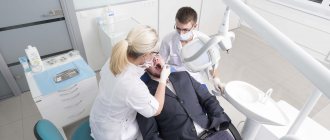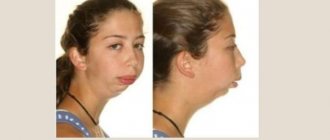Intraoral methods of mandibular anesthesia
Anesthesia is carried out by palpating bony anatomical landmarks and using the apodactyl method (without palpation). Mandibular anesthesia by palpation.
To carry it out, it is necessary to palpate to determine the location of the retromolar fossa and the temporal ridge, which is a guide for inserting the needle. From the coronoid process to the lingual side of the alveolar process of the lower jaw, a bone ridge descends - the temporal crest (crista temporalis). In the lower section, this ridge is divided into internal and external legs, which limit a small triangular area - the retromolar triangle. Between the anterior edge of the ramus of the lower jaw, which passes downwards into an oblique line (linea obliqua) and the temporal ridge, there is a small triangular depression - the posterior molar fossa (fovea retromolaris). Bony landmarks are palpated with the index finger of the left hand if anesthesia is performed on the right, or with the thumb if it is performed on the left. With the patient's mouth wide open, the anterior edge of the lower jaw branch is felt at the level of the distal edge of the crown of the third molar (if it is absent, immediately behind the second molar). By moving the finger slightly inward, the temporal ridge is identified, the projection of which is mentally transferred to the mucous membrane. The finger is fixed in the retromolar fossa. Having positioned the syringe at the level of the small molars of the opposite side, the needle is inserted medially from the temporal ridge and 0.75-1 cm above the chewing surface of the third major molar. Advance the needle outward and backward. At a depth of 0.5-0.75 cm it reaches the bone. After releasing 0.5-1 cm of anesthetic solution, the lingual nerve, which is located anterior to the inferior alveolar nerve, is turned off. Having advanced the needle another 2 cm, they reach the bone groove (sulcus colli mandibulae), where the lower alveolar nerve is located before it enters the canal of the lower jaw. Here, 2-3 ml of anesthetic is injected to turn off this nerve. The branch of the lower jaw is not located strictly in the sagittal plane, but at a certain angle to it, with its anterior edge lying closer and its posterior edge further from the midline. The severity of the inclination of the branch varies in different patients. Therefore, having inserted the needle to a depth of 0.75 cm to the bone and turning off the lingual nerve, it is not always possible to move it deeper to the mandibular foramen without changing the initial position of the syringe. It often becomes necessary to move the syringe to the level of the central incisors and move the needle posteriorly parallel to the inner surface of the mandibular ramus to a depth of 2 cm towards the mandibular foramen and sulcus colli mandibular
Apodactyl method of mandibular anesthesia.
When performing anesthesia using the apodactylic method, the main landmark is the pterygomandibular fold (plica pterigomandibularis). It is located medially from the temporal ridge and can be wide, narrow, or have a normal (medium) transverse size. With the patient's mouth wide open, the syringe is placed at the level of the small molars or the first large molar of the opposite side. The needle is inserted into the outer slope of the pterygomandibular fold in the middle of the distance between the chewing surfaces of the upper and lower large molars (in their absence, in the middle of the distance between the ridges of the alveolar processes). The needle is advanced outward and posteriorly until it contacts the bone tissue (to a depth of 1.5-2 cm), after which 2-3 ml of anesthetic is injected to turn off the inferior alveolar and lingual nerves. Sometimes, having advanced the needle to a depth of 2 cm, it is not possible to achieve contact with the bone. This may be due to the indicated anatomical features of the mandibular ramus, when its inclination to the sagittal plane is significantly pronounced. In this case, the needle, when immersed in the tissue, moves parallel to the inner surface of the jaw branch, without touching it. Then it is necessary to move the syringe even further in the opposite direction, placing it at the level of the second molar. By changing the angle between the inner surface of the branch and the needle, it is possible to achieve its contact with the bone. If the pterygomandibular fold is wide, the needle is inserted into the middle, if it is narrow, into its medial edge. The pterygomandibular fold is a less reliable landmark than the temporal crest, therefore, with the apodactyl method of anesthesia, it is not always possible to accurately deliver the anesthetic solution to the inferior alveolar nerve.
Extraoral methods of mandibular anesthesia
If it is impossible to block the inferior alveolar nerve using intraoral access, extraoral methods are used. Mandibular anesthesia with access from the submandibular region.
To more accurately perform anesthesia, it is rational to determine the projection of the opening of the lower jaw onto the skin.
It is located in the middle of a line drawn from the upper edge of the tragus of the auricle to the intersection of the anterior edge of the masticatory muscle with the base of the lower jaw. By moving the needle towards the mandibular foramen, you can focus on this point. The needle is inserted in the area of the base of the lower jaw, 1.5 cm anterior to the angle of the lower jaw. The needle is moved up 3.5-4 cm along the inner surface of the branch parallel to its posterior edge. At the same time, contact of the needle with the bone should be maintained. It is more convenient to insert the needle without a syringe and attach it only before injecting the anesthetic. Inject 2 ml of anesthetic solution. By moving the needle up, the lingual nerve is turned off another 1 cm. Subzygomatic method (Bershe-Dubov anesthesia).
The needle is inserted directly under the lower edge of the zygomatic arch, 2 cm anterior to the base of the tragus of the auricle.
The needle is placed perpendicular to the skin and advanced 3-3.5 cm to the midline strictly horizontally, gradually releasing the anesthetic solution. The needle extends between the heads of the external pterygoid muscle or onto its inner surface, where the inferior alveolar and lingual nerves are located nearby. After administration of 3-5 ml of anesthetic, pain relief occurs within 10-20 minutes. The zone of anesthesia when the lower alveolar and lingual nerves are turned off: all the teeth of the lower jaw of the corresponding half, the bone tissue of the alveolar process and part of the body of the lower jaw, the mucous membrane of the alveolar process on the vestibular and lingual side, the mucous membrane of the sublingual region and the anterior 2/3 of the tongue, skin and mucous membrane of the lower lip, skin of the chin on the side of anesthesia. It should be remembered that the mucous membrane of the alveolar process of the lower jaw from the middle of the second small molar to the middle of the second large molar is innervated not only by branches extending from the lower dental plexus, but also by the buccal nerve. To completely anesthetize this area of the mucous membrane, it is necessary to additionally inject 0.5 ml of anesthetic according to the type of infiltration anesthesia. Anesthesia during mandibular anesthesia most often occurs after 15-20 minutes, its duration is 1-1.5 hours. The severity of anesthesia in the area of the incisors and canines is less due to the anastomoses on the opposite side. Complications of mandibular anesthesia.
When a needle is inserted medial to the pterygomandibular fold, numbness of the pharyngeal tissue and damage to the internal pterygoid muscle are possible, followed by the appearance of contracture of the lower jaw. To eliminate this complication, long-term treatment is sometimes required using physiotherapeutic procedures, mechanotherapy and injections of pyrogenal solution. Damage to blood vessels and the occurrence of hemorrhage are possible, sometimes - the formation of a hematoma, and the entry of the anesthetic into the bloodstream, the appearance of ischemic zones on the skin of the lower lip and chin. When the lingual and inferior alveolar nerves are damaged by a needle, neuritis sometimes develops, for which galvanization and diathermy are used. Occasionally, paresis of facial muscles is observed due to blockade of the branches of the facial nerve. Due to a violation of the technique of mandibular anesthesia, a fracture of the injection needle is possible. This complication can occur when the initial position of the needle changes with a sharp movement, when its central end is deeply immersed in soft tissue or located between muscle and bone. The danger of this complication increases when the needle is inserted into a muscle tendon (usually the temporal muscle). The needle breaks at the point where it enters the cannula. To prevent this complication, you should use high-quality needles, strictly follow the anesthesia technique, do not immerse the needle into the tissue up to the cannula, and do not make rough and sudden movements of the needle. If the broken part of the needle is completely immersed in tissue, there should be no immediate attempt to remove it in the clinic. If indicated (pain spontaneously and when opening the mouth, development of contracture, inflammatory phenomena), removal of the needle is possible only in a hospital after a thorough x-ray examination. This labor-intensive procedure requires good operative technique and surgical experience. Sometimes a broken needle is encapsulated in tissue and does not cause complaints in patients. In these cases, it does not need to be deleted.
When and how torusal anesthesia is used in dentistry
This type of anesthesia is a variant of mandibular anesthesia, which is the most common way to eliminate pain sensitivity during medical procedures in the lower jaw . The essence of this type of anesthesia is to block the transmission of pain impulses by the lingual, buccal and inferior alveolar nerves passing through the mandibular foramen, the location of which is the inner surface of the lower jaw bone.
Torusal anesthesia consists of injecting an anesthetic solution into the area of the lower jaw where the mandibular ridge (torus) is located. The goal of the procedure is to simultaneously block the inferior alveolar, buccal and lingual nerves.
When using torusal anesthesia, pain relief occurs in areas such as:
- chin;
- area adjacent to the alveolar process;
- soft tissues of the oral cavity related to the lower jaw;
- corresponding areas of the facial skin.
One of the advantages of this method of depriving pain sensitivity is the absence of the need to change the angle of the syringe needle when administering an anesthetic drug during its injection into the torus - the area of the lower jaw ridge. This simplifies the anesthesia procedure.
When is torusal anesthesia used in dentistry?
The important advantages of this method are its simplicity and efficiency. It is thanks to this that the method has become widespread. This anesthesia technique allows treatment and extraction procedures to be performed on the entire row of lower teeth without the administration of additional doses of anesthetic. This anesthesia technique is used in the following cases:
- during surgical opening of ulcers in the oral cavity, for example, an abscess that developed due to inflammation of the periosteum;
- during medical procedures carried out on the lower teeth, in particular during depulpation;
- when teeth are pulled out - including in case of their abnormal location;
- in the treatment of mandibular bone fractures;
- when removing cysts and benign neoplasms in the lower jaw area, as well as during surgical operations on the mandibular bone (removal or, on the contrary, extension of areas of bone tissue).
The simplicity of the method and the speed of onset of the effect allow you to begin the treatment procedure almost immediately after the anesthetic injection.
Anesthetics used for torusal anesthesia, as well as for any other method of pain relief, may be allergens for a particular patient. Particularly severe allergic reactions occur in children. Therefore, when choosing a drug, the individual characteristics of the patient should be taken into account.
When injected into the torus area, all tissues are anesthetized, for the sensitivity of which the buccal, lingual and inferior alveolar nerves are responsible. Despite the fact that this anesthesia technique is relatively simple, the doctor using it must be properly qualified, since the success of blocking three nerves at once depends on the accuracy of insertion of the syringe needle.
If the doctor was inaccurate in determining the injection point, then the nerves may not be sufficiently blocked. The result is incomplete anesthesia of the relevant areas. In this case, the patient must tell the dentist that he still has a feeling of pain - then the doctor will take additional measures to eliminate pain sensitivity.
What is the technique of torusal anesthesia?
When applying the technique of this type of anesthesia, developed by Weisbrem, the patient must sit in the dental chair, throw back his head and open his mouth as wide as possible. The doctor makes an anesthetic injection into the gum so that the needle of the syringe with the anesthetic solution is strictly perpendicular to the inner surface of the cheek. In this case, the tip of the needle should reach the jawbone.
To localize the target point on the mucosa, it is necessary to identify the pterygomandibular fold in the oral cavity, which covers the pterygomandibular ligament of the same name. In the place between the fold and the buccal mucosa, you can find a depression that projects onto the mandibular ridge (torus) .
Thorusal anesthesia according to Weisbrem involves precise determination of the injection site. This place is located where the bony ridges coming from the condylar and coronoid processes meet. After an anesthetic injection, simultaneous blocking of the conductivity of the lingual, buccal and alveolar nerves should occur. During injection, the syringe needle should be at the level of the first or second of the main chewing teeth.
When the syringe needle is inserted as deep as possible, from one and a half to two milliliters of anesthetic solution is injected, after which a certain amount of the drug is drawn back into the syringe to check the presence of blood in the sampled liquid (aspiration test). If blood is found in the syringe when taking an aspiration sample, this indicates injury to a blood vessel.
After the first dose of anesthetic is administered, the syringe needle is pulled back slightly and no more than 0.5 milliliters of anesthetic is injected to block the lingual nerve. Pain relief occurs a maximum of five minutes after the injection.
In addition to the Weisbrem method, there are other methods of torusal anesthesia developed by Akinozi, Gou-Gates, Legardi and other doctors.
Method of torusal anesthesia according to Akinozi
is that the syringe needle does not contact the jaw bone, and the patient does not need to open his mouth wide. When performing anesthesia using this method, a patient whose teeth are closed is slowly injected with one and a half to two milliliters of anesthetic solution into a point located in the interval between the tubercle of the lower jaw and its abduction. Thus, the drug acts on the nerve endings located in this area. The Akinosi method allows you to block the alveolar and lingular nerves.
Technique of torusal anesthesia
Anesthesia according to Akinozi is rarely used - in cases where other methods of pain relief do not give the desired result. The reason for the limited use of this technique is the high risk of complications such as:
- spasm of the masticatory muscles due to damage to the temporal or pterygoid muscles;
- periosteum injury;
- facial nerve injury.
Torusal anesthesia in dentistry: zone of anesthesia using the Akinosi technique
Due to the high risk of complications, only an experienced dentist can use Akinosi anesthesia. The riskiness of the procedure is its main disadvantage. The advantage of this method of anesthesia is that it is the best additional measure for those patients who have more than three nerves in the tooth.
Gow-Gates Method
This method, developed by the Australian dentist Gou-Gates, is very complex, but in ninety-seven percent of cases it gives the expected effect.
Anesthesia according to Go-Gates
The essence of this method is that the patient’s lower jaw is rotated relative to the frontal axis so that the head of the condylar process moves forward onto the articular eminence and the relative position of the mandibular nerve and the site of injection of the anesthetic solution changes.
Gow-Gates Method
The technique of torusal anesthesia according to Go-Gates includes the following steps:
- choosing the most suitable relationship between the doctor and the patient;
- placing the syringe in the corner of the lips with the patient’s mouth as wide open as possible;
- insertion of a syringe needle into the tendon of the temporal muscle in the pterygomaxillary region;
- slowly advancing the needle to the jawbone;
- performing an aspiration test;
- if there is no blood in the syringe, slowly inject one capsule of anesthetic;
After injecting the drug, the patient must sit for several minutes with his mouth open until complete pain relief occurs.
1 – Buccal nerve (n. buccalis) 2 – Corda tympani (chorda tympani) 3 – Masticatory nerve (n. massetericus) 4 – Lower alveolar nerve (n. alveolaris inferior) 5 – Incisive nerve (n. incisivus)
This technique blocks conductivity:
- inferior alveolar nerve;
- buccal nerve;
- lingual nerve;
- auriculotemporal nerve;
- mylohyoid nerve.
Carelessness during the injection can lead to the appearance of a hematoma. In addition, the patient may experience breathing difficulties.
The Go-Gates method has the following advantages:
- high performance;
- the ability to determine the injection site with high accuracy;
- low risk of complications.
Anesthesia zone with Go-Gates anesthesia
The disadvantage of the technique is the slow onset of the effect - several minutes later than when using other techniques.








